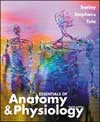 |
1 |  | 
______ surrounds each muscle fasciculus, whereas ______ surrounds each muscle fiber. |
|  | A) | epimysium, perimysium |
|  | B) | perimysium, endomysium |
|  | C) | epimysium, endomysium |
|  | D) | endomysium, perimysium |
|  | E) | endomysium, epimysium |
 |
 |
2 |  | 
The basic structural and functional unit of skeletal muscle is the |
|  | A) | fiber. |
|  | B) | fasciculus. |
|  | C) | myofibril. |
|  | D) | sarcomere. |
|  | E) | whole muscle. |
 |
 |
3 |  | 
Which of these units contains overlapping actin and myosin myofilaments? |
|  | A) | A band |
|  | B) | H zone |
|  | C) | I band |
|  | D) | M line |
|  | E) | Z disk |
 |
 |
4 |  | 
Which of these is NOT a part of the actin myofilament? |
|  | A) | actin |
|  | B) | sarcolemma |
|  | C) | tropomyosin |
|  | D) | troponin |
 |
 |
5 |  | 
Each muscle cell is a |
|  | A) | fasciculus. |
|  | B) | sarcomere. |
|  | C) | fiber. |
|  | D) | myofibril. |
|  | E) | myofilament. |
 |
 |
6 |  | 
To establish the resting membrane potential, |
|  | A) | sodium ions diffuse into the cell. |
|  | B) | sodium ions diffuse out of the cell. |
|  | C) | potassium ions diffuse into the cell. |
|  | D) | potassium ions diffuse out of the cell. |
|  | E) | large negative molecules diffuse out of the cell. |
 |
 |
7 |  | 
Before being released from the axon of a neuron, acetylcholine is stored in the |
|  | A) | synaptic vesicles. |
|  | B) | synaptic cleft. |
|  | C) | muscle fiber. |
|  | D) | postsynaptic membrane. |
|  | E) | sarcoplasmic reticulum. |
 |
 |
8 |  | 
During the process of muscle contraction, calcium ions bind to the |
|  | A) | presynaptic terminal. |
|  | B) | sarcolemma. |
|  | C) | synaptic vesicles. |
|  | D) | tropomyosin molecules. |
|  | E) | troponin molecules. |
 |
 |
9 |  | 
During muscle contraction, which of these processes requires ATP? |
|  | A) | calcium ions are moved back to the sarcoplasmic reticulum |
|  | B) | cross-bridges are released |
|  | C) | heads of the myosin myofilaments are bent toward the center of the sarcomere |
|  | D) | heat is released |
|  | E) | all of these |
 |
 |
10 |  | 
Even though each muscle fiber responds in all-or-none fashion, a whole muscle can contract with varying force because of |
|  | A) | different threshold values. |
|  | B) | total tetanus of the muscle. |
|  | C) | recruitment of additional motor units. |
|  | D) | rigor mortis. |
|  | E) | the lag phase of contraction. |
 |
 |
11 |  | 
Anaerobic respiration |
|  | A) | produces 36-38 ATP per glucose molecule. |
|  | B) | produces an oxygen debt. |
|  | C) | occurs in resting muscles or muscles undergoing long-term exercise. |
|  | D) | can use fatty acid to produce ATP. |
|  | E) | all of these |
 |
 |
12 |  | 
Fast-twitch muscle fibers |
|  | A) | are more resistant to fatigue than slow-twitch fibers. |
|  | B) | have a richer blood supply than slow-twitch fibers. |
|  | C) | have a larger amount of stored glycogen than slow-twitch fibers. |
|  | D) | have more mitochondria than slow-twitch fibers. |
|  | E) | have more myoglobin than slow-twitch fibers. |
 |
 |
13 |  | 
Two muscles that are antagonists are the |
|  | A) | rectus femoris and vastus lateralis. |
|  | B) | vastus medialis and vastus intermedius. |
|  | C) | adductor longus and vastus lateralis. |
|  | D) | rectus femoris and semimembranosus. |
|  | E) | gluteus maximus and semitendinosus. |
 |
 |
14 |  | 
If a woman raised her arms straight out pointing right and left, level with her shoulders, she mostly used her |
|  | A) | biceps brachii muscles. |
|  | B) | latissimus dorsi muscles. |
|  | C) | pectoralis major muscles. |
|  | D) | deltoid muscles. |
|  | E) | all of these |
 |
 |
15 |  | 
Which of these muscles flexes both the arm and the forearm? |
|  | A) | biceps brachii. |
|  | B) | brachialis. |
|  | C) | deltoid. |
|  | D) | latissimus dorsi. |
|  | E) | triceps brachii. |
 |



 2002 McGraw-Hill Higher Education
2002 McGraw-Hill Higher Education